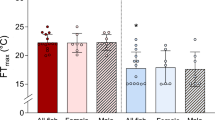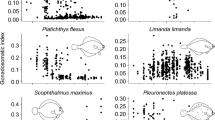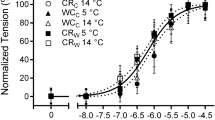Abstract
Upon reaching sexual maturity, several species of male salmonids possess a relative ventricular mass (rMV) that may be up to 90% larger than females. This can increase maximum cardiac stroke volume and power output, which may be beneficial to increasing the oxygen transport capacity of male salmonids during the spawning period. It may be further hypothesized, therefore, that other variables within the circulatory oxygen transport cascade, such as blood oxygen-carrying capacity and heart rate, are similarly enhanced in reproductively mature male salmonids. To test this idea, the present study measured a range of circulatory oxygen transport variables in wild male and female sockeye salmon (Oncorhynchus nerka) during their spawning period, following a 150 km migration from the ocean. The rMV of male fish was 13% greater than females. Conversely, the haemoglobin concentration ([Hb]) of female fish was 19% higher than males, indicative of a greater blood oxygen-carrying capacity (138 vs. 116 ml O2 l−1, respectively). Surgically implanted physiological data loggers revealed a similar range in heart rate for both sexes on the spawning ground (20–80 beats min−1 at 10°C), with a tendency for male fish to spend a greater percentage of time (64%) than females (49%) at heart rates above 50 beats min−1. Male fish on average consumed significantly more oxygen than females during a 13-h respirometry period. However, routine oxygen consumption rates \( (\dot{M}{\text{O}}_{2} ) \) ranged between 1.5 and 8.5 mg min−1 kg−1 for both sexes, which implies that males did not inherently possess markedly higher routine aerobic energy demands, and suggests that the higher [Hb] of female fish may compensate for the smaller rMV. These findings reject the hypothesis that all aspects of the circulatory oxygen transport cascade are inherently superior in male sockeye salmon. Instead, it is suggested that any differences in \( \dot{M}{\text{O}}_{2} \) between sexually mature male and female sockeye salmon can likely be attributed to activity levels.






Similar content being viewed by others
References
Altimiras J, Johnstone ADF, Lucas MC, Priede IG (1996) Sex differences in the heart rate variability spectrum of free-swimming Atlantic salmon (Salmo salar L.) during the spawning season. Physiol Zool 69:770–784
Armstrong JD, West CL (1994) Relative ventricular weight of wild Atlantic salmon parr in relation to sex, gonad maturation and migratory activity. J Fish Biol 44:453–457
Bailey JR, West JL, Driedzic WR (1997) Heart growth associated with sexual maturity in male rainbow trout (Oncorhynchus mykiss) is hyperplastic. Comp Biochem Physiol B 188:607–611
Brett JR (1995) Energetics. In: Groot C, Margolis L, Clarke WC (eds) Physiological ecology of Pacific salmon. University of British Columbia Press, Vancouver, pp 3–68
Clark RJ, Rodnick KJ (1998) Morphometric and biochemical characteristics of ventricular hypertrophy in male rainbow trout (Oncorhynchus mykiss). J Exp Biol 210:1541–1552
Clark RJ, Rodnick KJ (1999) Pressure and volume overloads are associated with ventricular hypertrophy in male rainbow trout. Am J Physiol Regul Integr Comp Physiol 277:R938–R946
Clark TD, Eliason EJ, Sandblom E, Hinch SG, Farrell AP (2008a) Calibration of a hand-held haemoglobin analyser for use on fish blood. J Fish Biol 73:2587–2595
Clark TD, Sandblom E, Cox GK, Hinch SG, Farrell AP (2008b) Circulatory limits to oxygen supply during an acute temperature increase in the Chinook salmon (Oncorhynchus tshawytscha). Am J Physiol Regul Integr Comp Physiol 295:1631–1639
Clark TD, Taylor BD, Seymour RS, Ellis D, Buchanan J, Fitzgibbon QP, Frappell PB (2008c) Moving with the beat: heart rate and visceral temperature of free-swimming and feeding bluefin tuna. Proc R Soc B Biol Sci 275:2841–2850
Davie PS, Thorarensen H (1997) Heart growth in rainbow trout in response to exogenous testosterone and 17-alpha methyltestosterone. Comp Biochem Physiol A 117:227–230
Farrell AP, Hinch SG, Cooke SJ, Patterson DA, Crossin GT, Lapointe M, Mathes MT (2008) Pacific salmon in hot water: applying aerobic scope models and biotelemetry to predict the success of spawning migrations. Physiol Biochem Zool 81:697–709
Franklin CE, Davie PS (1992) Sexual maturity can double heart mass and cardiac power output in male rainbow trout. J Exp Biol 171:139–148
Gallaugher P, Farrell AP (1998) Hematocrit and blood oxygen-carrying capacity. In: Perry SF, Tufts B (eds) Fish respiration, fish physiology series, vol 17. Academic Press, San Diego, pp 185–227
Gamperl AK, Farrell AP (2004) Cardiac plasticity in fishes: environmental influences and intraspecific differences. J Exp Biol 207:2539–2550
Graham MS, Farrell AP (1989) Effect of temperature acclimation on cardiac performance in a perfused trout heart. Physiol Zool 62:38–61
Graham MS, Farrell AP (1990) Myocardial oxygen consumption in trout acclimated to 5°C and 15°C. Physiol Zool 63:536–554
Graham MS, Farrell AP (1992) Environmental influences on cardiovascular variables in rainbow trout, Oncorhynchus mykiss (Walbaum). J Fish Biol 41:851–858
Healey MC, Lake R, Hinch SG (2003) Energy expenditures during reproduction by sockeye salmon (Oncorhynchus nerka). Behavior 140:161–182
Hinch SG, Rand PS (1998) Swim speeds and energy use of upriver-migrating sockeye salmon (Oncorhynchus nerka): role of local environment and fish characteristics. Can J Fish Aquat Sci 55:1821–1831
Horvath L (1986) Carp oogenesis and the environment. In: Billard R, Marcel J (eds) Aquaculture of cyprinids. INRA, Paris, pp 109–117
Hruska KA, Hinch SG, Healey MC, Farrell AP (2007) Electromyogram telemetry, nondestructive physiological biopsy, and genetic markers: linking recent techniques with behavioral observations for the study of reproductive success in sockeye salmon mating systems. Am Fish Soc Symp 54:17–29
Lefter KK, Hegyi A, Baska F, Gal J, Horvath A, Urbanyi B, Szabo T (2008) Comparison of ovarian cycles of Hungarian riverine fish species representing different spawning strategies. Czech J Anim Sci 10:441–452
Lucas MC, Johnstone ADF, Priede IG (1993) Use of physiological telemetry as a method of estimating metabolism of fish in the natural environment. Trans Am Fish Soc 122:822–833
Luk’yanenko VI, Raspopov VM (1972) Sexual dimorphism and seasonal dynamics of the morphological parameters of the Russian sturgeon in the river period of life. In Tez Otchetn sessii Tsentr. n. -i. in-ta osetrovogo kh-va (summary of a review session of the Central Sturgeon Fisheries Research Institute), Astrakhan
Pan W-H, Habicht J-P (1991) The non-iron-deficiency-related difference in hemoglobin concentration distribution between blacks and whites and between men and women. Am J Epidemiol 134:1410–1416
Pickering AD (1986) Changes in blood cell composition of the brown trout. Salmo trutta L., during the spawning season. J Fish Biol 29:335–347
Steinhausen MF, Sandblom E, Eliason EJ, Verhille C, Farrell AP (2008) The effect of acute temperature increases on the cardiorespiratory performance of resting and swimming sockeye salmon (Oncorhynchus nerka). J Exp Biol 211:3915–3926
Thorarensen H, Knight C, Davie PS (1996a) Seasonal changes in 11-ketotestosterone and relative ventricle mass in wild rainbow trout, Oncorhynchus mykiss. N Z J Mar Freshwater Res 30:397–402
Thorarensen H, Young G, Davie PS (1996b) 11-ketotestosterone stimulates growth of heart and red muscle in rainbow trout. Can J Zool 74:912–917
Wilson RP, White CR, Quintana F, Halsey LG, Liebsch N, Martin GR, Butler PJ (2006) Moving towards acceleration for estimates of activity-specific metabolic rate in free-living animals: the case of the cormorant. J Anim Ecol 75:1081–1090
Acknowledgments
We thank the staff of Weaver Creek spawning channel, particularly Rick Stitt, Wayne Charlie and Heather East, for their hospitality and assistance, and we are grateful to Georgina Cox, Erika Eliason, Ken Jeffries and Andrew Lotto for their assistance during data logger implantation and observations of tagged fish. TDC was supported by a Killam Postdoctoral Fellowship. APF and SGH were supported by funding through NSERC Canada. All experimental procedures were approved by the Animal Care Committee of the University of British Columbia in accordance with the Canadian Council on Animal Care.
Author information
Authors and Affiliations
Corresponding author
Additional information
Communicated by I. D. Hume.
Rights and permissions
About this article
Cite this article
Clark, T.D., Hinch, S.G., Taylor, B.D. et al. Sex differences in circulatory oxygen transport parameters of sockeye salmon (Oncorhynchus nerka) on the spawning ground. J Comp Physiol B 179, 663–671 (2009). https://doi.org/10.1007/s00360-009-0349-1
Received:
Revised:
Accepted:
Published:
Issue Date:
DOI: https://doi.org/10.1007/s00360-009-0349-1




